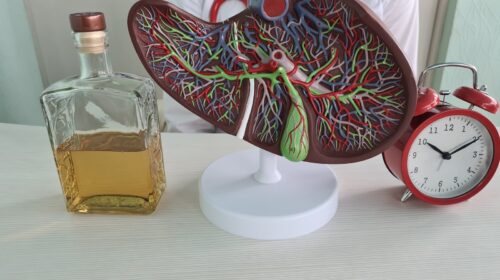Vicodin® is a powerful pain reliever used to treat severe pain after injuries or surgeries. The painkiller has an average half-life of 3.8 to 4.9 hours, and, on average, it can take up to 1 to 4 days for Vicodin® to be cleared from the body.
However, it can also be misused or abused, leading to serious health consequences. For this reason, it’s crucial to know how long Vicodin® stays in your system and how it interacts with other medications you may be taking.
What Exactly Is Vicodin® ?
Vicodin® is a widely prescribed pain medication that falls under narcotic opioid drugs[1]. It is composed of two primary active ingredients – hydrocodone and acetaminophen. Hydrocodone functions as an opioid pain reliever that impacts the pain receptors in your brain and nervous system. In contrast, acetaminophen acts as a non-opioid pain reliever and decreases fever.
Vicodin® is an effective painkiller, but it also comes with side effects. The most common ones are nausea, dizziness, drowsiness, constipation, and dry mouth. While these side effects are generally mild, there are rare cases where Vicodin® can cause more severe problems, including difficulty breathing or an allergic reaction.
If you start feeling any of these severe side effects, seeking immediate medical attention is crucial.
Vicodin® contains the opioid hydrocodone[2], which increases its potential for abuse and addiction. Using or abusing it for prolonged periods can cause physical dependence, resulting in withdrawal symptoms if abruptly ceased.
It’s important to note that taking Vicodin® in higher doses or more frequently than prescribed heightens the risk of overdose and addiction.
How Long Does Vicodin® Stay In Your System?
The active ingredient in Vicodin® , hydrocodone, has an average half-life of 3.8 to 4.9 hours. Half of the drug dose will leave the body within that time frame. However, it may take up to five half-lives for the drug to be entirely removed from the system.
On average, Vicodin® can take up to 1 to 4 days to be cleared from the body, but detection times in drug tests can be longer: up to 4 days in urine, 24 hours in blood, 36 hours in saliva, and up to 90 days in hair.
Factors Affecting How Long Vicodin® Stays In Your System
Below are some of the factors that can influence how long Vicodin® stays in your system:
Dosage and Frequency of Use
The dosage and usage frequency are significant factors that determine how long Vicodin® remains in your system. Higher doses or frequent use of the drug lead to a longer time required to metabolize and eliminate it. Typically, it takes about four hours for the body to eliminate half of the drug, known as its half-life. Hence, higher doses or more frequent use of Vicodin® result in longer elimination times.
Body Metabolism
If you have a fast metabolism, Vicodin® could be eliminated from your system in a shorter period. Conversely, if you have a slower metabolism, it may take longer to break down and stop the medication.
Liver and Kidney Function
Your liver and kidneys play a vital role in removing Vicodin® from your body. This is because the liver metabolizes drugs, whereas the kidneys eliminate drugs. Therefore, Vicodin® will take longer to break down and exit your system if you have a damaged liver or kidneys.
On the other hand, if your liver or kidneys are healthy, they can metabolize and eliminate Vicodin® faster.
Age and Gender
Age and gender affect how long Vicodin® stays in your system. As we age, our metabolism slows, causing drugs to stay longer. Also, women tend to metabolize Vicodin® more slowly than men due to differences in hormone balances, which impact how long the drug remains in their bodies.
Other Medications and Substances
Other substances and medications can affect Vicodin® ‘s stay in your system. For example, some drugs can slow down their metabolism, making them linger in your system longer.
However, combining Vicodin® with some substances can speed up eliminating it from your body. Mixing it with alcohol or other substances can also influence its duration in your system.
Detection Methods for Vicodin®
Detecting Vicodin® in the body can be done through several methods. These include:
Urine Testing
Urine tests[3] are the most common way to detect Vicodin® in your system. Urine samples are tested for the presence of hydrocodone and its metabolites. The test is sensitive enough to detect even small amounts of the drug. It can be detected up to 3-4 days after the last use, depending on how often it was taken and the user’s metabolism.
Blood Testing
Blood tests are less commonly used to detect Vicodin® abuse, but they can be more accurate than urine tests. The test can detect Vicodin® in the bloodstream within hours of use. However, blood tests are more expensive, less convenient, and less frequently used than urine tests.
Hair Testing
Hair testing is a modern method of detecting Vicodin® abuse that requires a hair sample from the tested person. The sample is then sent to a laboratory where it’s analyzed for drug use. Hair testing can detect drug use up to 90 days after the last use, making it a technique with a broader detection window, but not necessarily more accurate than other methods.
Saliva Testing
Saliva testing offers a non-intrusive and distinctive method for detecting Vicodin® . This test involves taking a sample of saliva through a simple mouth swab. Within a few hours of use, the test can detect Vicodin® use with high accuracy. The swab is placed in your mouth for approximately two minutes until it is saturated and then submitted for testing.
Sweat Patch Testing
Sweat patch testing is a relatively new method of drug detection. This involves placing a sweat patch on your skin, which absorbs the sweat and any drugs present in it. The patch is then collected and sent to a laboratory for analysis. It can detect Vicodin® use within the past week or so, making it useful for detecting recent drug use.
Learn More About How Long It Takes Prescription Drugs to Exit Your System
To learn more about how Vicodin® and other substances interact with the body and how long they take to become metabolized, check out these additional resources.

























